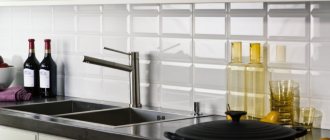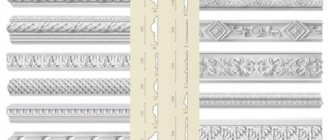Classification
Decorative lighting using various schemes has replaced the only round or square lampshade traditionally installed on the ceiling. And if previously the main light source was enough, now modern interior design offers many options that expand the idea of how best to arrange your bathroom.
Lamps can be placed on the wall, ceiling, floor, or connected to different switches. Thanks to this, it becomes possible to control the lighting in the bathroom.
In conclusion
For a small bathroom of 4 sq.m. has become a functional room, it is important to create the right lighting. Traditionally, ceiling lighting is used in bathrooms. Typically, this is a spotlight version or LED. For user convenience, additional side light sources should be used. A decorative method is also possible, which involves inserting lamps into the floor. But no matter which option is chosen, it is important to remember the safety and high quality of all lighting elements.
Types of lamps
The modern market offers various types of lamps and devices:
Raster. Aluminum grilles mounted on the ceiling, included in the design of this lamp model, reflect the light and make it three-dimensional.
LED. Minimal power consumption and independence from voltage surges are their huge advantages. Cons: high cost.
Built-in. Installed during ceiling installation.
Spotlights. They serve more decorative functions. Reliable, practical. Allows targeted illumination of a specific area. Easily serve as main lighting.
Invoices. They are installed after all construction work in special holes in the ceiling or wall.
Luminescent. Also called energy saving. Gives uniform bright light.
Durolites. Flexible mounting strips with LED bulbs and resistors. They are usually installed around the perimeter. They often function as garlands.
Lighting design
By using backlighting, certain visual benefits can be achieved.
For example, LED lighting along the perimeter of the ceiling can make it visually higher. The same effect is obtained if such lighting is implemented on the wall.
Bathroom lighting is a great way to visually indicate which area is which. So, for example, lighting a mirror or lighting furniture in the bathroom will well emphasize their shape and effectively indicate them in the interior.
Bathroom lighting design
If the room has a spacious area, then using it you can effectively highlight the bath itself. It is also worth noting that today there are bathtub models that already have built-in lighting.
Bathroom lighting
Placement of lamps
Based on the nature of their placement, luminaires are divided into the following categories:
- To illuminate the mirror;
- Ceiling;
- Floor-standing;
- Wall-mounted.
Lamps for slatted and suspended ceilings
When decorating a bathroom, it is important to choose the right lighting and create good visibility. At the same time, it is important that the intensity of illumination can be adjusted. To take a bath with aromatic oils, you are unlikely to need bright light, but dim light is just right.
To decorate slatted and suspended ceilings in the bathroom, spotlights, surface-mounted and recessed lamps with LED lamps are used.
This kind of illumination has its significant advantages:
- Energy saving of the highest level.
- Long service life;
- Lamps are economical;
- Availability of high-quality transformers that protect the entire device from power outages.
- The ability to create panoramic lighting in a tiny bathroom.
A huge disadvantage of such LED lamps and the equipment necessary for their installation (transformers, ventilation system) is their high cost.
- Slatted ceiling in the bathroom: installation features, installation rules and optimal combinations of materials (125 photos)
Plastic ceiling in the bathroom: 110 photos of choosing optimal designs, panels and lighting
- Plasterboard ceiling in the bathroom: preparation of surfaces and installation of structures. 115 photos and installation instructions
Light in the bathroom
Even if we proceed from the standards, this is clearly not enough. After all, when we wash or apply makeup, we need lighting no worse than natural daylight. As a rule, even in apartments, the ceiling lamp above the door is quickly replaced with something more aesthetically pleasing and attractive. Let's consider the possibilities of placing diverse functional lamps in the bathroom.
Full and partial lighting in the bathroom
If the bathroom allows it, and you are making spotlights in a multi-level ceiling, make sure that it is possible to turn on not all points at once, but in at least two or three options: central ones, those that go along the perimeter of the ceiling, or four corner lights should be turned off autonomous from each other. Full light is required for cleaning and washing, but you can take a bath in partial light.
Make sure that above the mirror there is either one lamp in the center, or two at the edges. The choice of wall lamps of various styles today is so wide and varied that you can easily choose matching point and wall spots, the holder and rotation of which are adjustable in length and angle of inclination.
Every morning begins in this room , so it should please you with both the aesthetics of the overall decor and the harmonious lighting. Let it be a bright light in the morning, and in the evening, while relaxing in the bath, you can leave only a wall lamp above the mirror or a couple of points under the ceiling.
Lamps in the bathroom are its main decoration!
If you are lucky and your bathroom is more spacious than usual, you can “play” with the lighting so that your evening relaxation becomes a real holiday every time. One of the options is the “starry sky” in various transformations. Another possibility is well-chosen colored flashlights designed for rooms with high humidity.
If you have a high ceiling, you can choose an interesting pendant model of the central lamp and several built-in spotlights around the perimeter. In combination with a round mirror on both sides, overhead matte round lampshades of the same diameter will look great. In a Japanese style interior, you can place several bamboo lanterns. Ultra-modern style involves lamps with clear lines and regular geometric shapes. Oriental style is looking for lamps with stained glass and a simple frame, or, conversely, with an ornamental frame and simple glass. A minimalist style may require LED lighting around the perimeter (or diameter) of the mirror. If there is a shower stall in the bathroom, it should have independent lighting.
If you have a large mirror, the lamps can be attached directly to the glass, and the light will be multiplied due to reflection. If there are two mirrors: above the sink and above the bathtub, the one above the sink should be illuminated by open direct light with a wide dispersion angle, and the one above the bathtub should be illuminated by hidden light, released behind the ceiling ledge or from a special cornice or niche. You can make a decorative glass or mirror wall right behind the bathtub by “scattering” LED lights across its surface.
Bathroom light - original solutions and safety precautions
If the bathroom has a window, the rest of the lamps are not canceled, as in ordinary rooms, but above the window you can hang a flashlight that is turned on in the evenings. Hanging cabinets can also have their own lighting, so you don't have to turn on the full light every time to find something you need.
Another exclusive point is floor lighting, when spotlights are built around the bathtub. With the overhead lights turned off, the spectacle is unforgettable!
Sockets in the bathroom should be located at the maximum distance from the sink; exposed wiring is unacceptable; grounding is required. If task lighting is required for the washing machine, it can be a single lamp in the general bathroom style with an adjustable holder.










